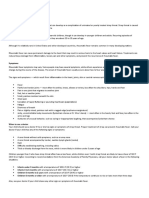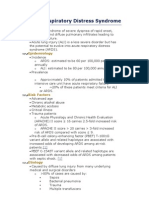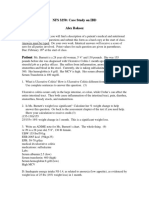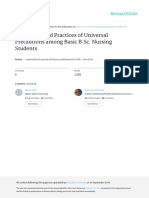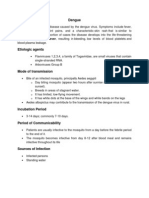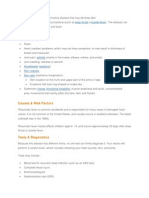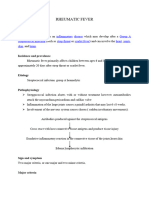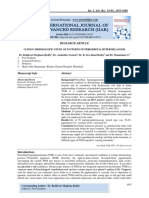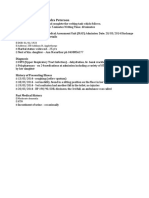Rheumatic Fever
Rheumatic Fever
Uploaded by
Panji SaksonoCopyright:
Available Formats
Rheumatic Fever
Rheumatic Fever
Uploaded by
Panji SaksonoOriginal Description:
Copyright
Available Formats
Share this document
Did you find this document useful?
Is this content inappropriate?
Copyright:
Available Formats
Rheumatic Fever
Rheumatic Fever
Uploaded by
Panji SaksonoCopyright:
Available Formats
Rheumatic fever
Rheumatic fever is an inflammatory disease that may develop after an infection with group A Streptococcus bacteria (such as strep throat or scarlet fever). The disease can affect the heart, joints, skin, and brain.
Causes
Rheumatic fever is common worldwide and is responsible for many cases of damaged heart valves. It is not common in the United States, and usually occurs in isolated outbreaks. The latest outbreak was in the 1980s. Rheumatic fever mainly affects children ages 5 -15, and occurs approximately 14-28 days after strep throat or scarlet fever.
Symptoms
Abdominal pain Fever Heart (cardiac) problems, which may not have symptoms, or may result in shortness of breath and chest pain Joint pain, arthritis (mainly in the knees, elbows, ankles, and wrists) Joint swelling; redness or warmth Nosebleeds (epistaxis) Skin nodules Skin rash (erythema marginatum) o Skin eruption on the trunk and upper part of the arms or legs o Eruptions that look ring-shaped or snake-like Sydenham chorea (emotional instability, muscle weakness and quick, uncoordinated jerky movements that mainly affect the face, feet, and hands)
Exams and Tests
Your doctor or nurse will examine you. This will include carefully checking your heart sounds, skin, and joints. Tests may include:
Blood test for recurrent strep infection (such as an ASO test) Complete blood count Electrocardiogram Sedimentation rate (ESR)
Several major and minor criteria have been developed to help standardize rheumatic fever diagnosis. Meeting these criteria, as well as having evidence of a recent streptococcal infection, can help confirm that you have rheumatic fever.
The major criteria for diagnosis include:
Arthritis in several large joints (polyarthritis) Heart inflammation (carditis) Nodules under the skin (subcutaneous skin nodules) Rapid, jerky movements (chorea, Sydenham chorea) Skin rash (erythema marginatum)
The minor criteria include:
Fever High ESR Joint pain Abnormal EKG
You'll likely be diagnosed with rheumatic fever if you meet two major criteria, or one major and two minor criteria, and have signs that you've had a previous strep infection.
Treatment
If you are diagnosed with acute rheumatic fever you will be treated with antibiotics. Anti-inflammatory medications such as aspirin or corticosteroids reduce inflammation to help manage acute rheumatic fever. You may have to take low doses of antibiotics (such as penicillin, sulfadiazine, or erythromycin) over the long term to prevent strep throat from returning.
Outlook (Prognosis)
If rheumatic fever returns, your doctor may recommend you take low-dose antibiotics continually, especially during the first 3 -5 years after the first episode of the disease. Heart complications may be severe, particularly if the heart valves are involved.
Possible Complications
Arrhythmias Damage to heart valves (in particular, mitral stenosis and aortic stenosis) Endocarditis Heart failure Pericarditis Sydenham chorea
When to Contact a Medical Professional
Call your health care provider if you develop symptoms of rheumatic fever. Because several other conditions have similar symptoms, you will need careful medical evaluation.
If you have symptoms of strep throat, tell your health care provider. You will need to be evaluated and treated if you do have strep throat, to decrease your risk of developing rheumatic fever.
Prevention
The most important way to prevent rheumatic fever is by getting quick treatment for strep throat and scarlet fever.
Alternative Names
Acute rheumatic fever
References
Low DE. Nonpneumococcal streptococcal infections, rheumatic fever. In: Goldman L, Schafer AI, eds. Cecil Medicine. 24th ed. Philadelphia, Pa: Saunders Elsevier; 2011:chap 298.
http://www.nlm.nih.gov/medlineplus/ency/article/003940.htm
1) Dekompensasi Cordis Peristiwa dekompensasi cordis pada bayi dan anak menggambarkan terdapatnya sindroma klinik akibat myocardium tidak mampu memenuhi keperluan metabolic termasuk pertumbuhan. Keadaan ini timbul karena kerja otot jantung yang berlebihan, biasanya karena kelainan struktur jantung, kelainan otot jantung sendiri seperti proses inflamasi atau gabungan kedua faktor tersebut. Pada umumnya payah jantung pada anak diobati secara klasik yaitu dengan digitalis dan obat-obat diuretika. Tujuan pengobatan ialah menghilangkan gejala (simptomatik) dan yang paling penting mengobati penyakit primer. 2) Pericarditis Peradangan pada pericard visceralis dan parietalis yang bervariasi dari reaksi radang yang ringan sampai tertimbunnnya cairan dalam cavum pericard.
You might also like
- Neuro ObsDocument1 pageNeuro ObsAristotle Javier100% (1)
- KawasakiDocument28 pagesKawasakiLaith DmourNo ratings yet
- Care PlanningDocument14 pagesCare PlanningpriscellaNo ratings yet
- Rheumatic FeverDocument3 pagesRheumatic FeverKhalid Mahmud Arifin100% (3)
- Immediate Function and Esthetics in Implant DentistryDocument114 pagesImmediate Function and Esthetics in Implant Dentistryamirmaafi100% (1)
- The Success of Atty. Erwin Erfe, M.D. in Medicine and Law PDFDocument30 pagesThe Success of Atty. Erwin Erfe, M.D. in Medicine and Law PDFCzeska FranciscoNo ratings yet
- Rheumatic FeverDocument6 pagesRheumatic FeverchrisNo ratings yet
- Rheumatic FeverDocument3 pagesRheumatic FeverKennette LimNo ratings yet
- Rheumatic FeverDocument6 pagesRheumatic FeverSam AraNo ratings yet
- Rheumatic Endocarditis: o o o o oDocument5 pagesRheumatic Endocarditis: o o o o ogaratoh099No ratings yet
- Rheumatic Fever Small Group DiscussionDocument13 pagesRheumatic Fever Small Group DiscussionLyca Mae AurelioNo ratings yet
- Pravin Prakash P - Finalyearmsc N Navodayacollegeof NursingDocument9 pagesPravin Prakash P - Finalyearmsc N Navodayacollegeof NursingpraywinNo ratings yet
- Case 8 NCP (Multiple Sclerosis)Document2 pagesCase 8 NCP (Multiple Sclerosis)je-ann catedralNo ratings yet
- Rheumatic FeverDocument8 pagesRheumatic Feverjethro sanchezNo ratings yet
- DIARHEADocument7 pagesDIARHEAahmedmuuseabokorNo ratings yet
- Case Study Tension Pneumothorax BSN 4 2 1Document57 pagesCase Study Tension Pneumothorax BSN 4 2 1aaron tabernaNo ratings yet
- Acute Respiratory Distress SyndromeDocument10 pagesAcute Respiratory Distress Syndromealina abu rumiNo ratings yet
- Anemia Anemia Describes The Condition in Which The Number of Red Blood Cells in The Blood Is Low. Probability & StatisticsDocument7 pagesAnemia Anemia Describes The Condition in Which The Number of Red Blood Cells in The Blood Is Low. Probability & StatisticsSahara GalayNo ratings yet
- PnuemoniaDocument102 pagesPnuemoniaRegineCuasSulibNo ratings yet
- Asthma and Status AsthmaticusDocument19 pagesAsthma and Status Asthmaticussharon mogambiNo ratings yet
- Dengue FeverDocument7 pagesDengue FeverAmber Hope PonsicaNo ratings yet
- EPIGLOTTITISDocument11 pagesEPIGLOTTITISMinutes in MEDITATIONNo ratings yet
- Heat Stroke, Cramps and Exhaustion (Report)Document29 pagesHeat Stroke, Cramps and Exhaustion (Report)Operio AndreaNo ratings yet
- DrowningDocument7 pagesDrowningmedhatsabriNo ratings yet
- 21.child With Diarrhea and Vomiting-SeminarDocument65 pages21.child With Diarrhea and Vomiting-SeminarRhomizal MazaliNo ratings yet
- Tetanus: HistoryDocument15 pagesTetanus: HistorydanielleNo ratings yet
- 1.0 Upper Airway InfectionsDocument45 pages1.0 Upper Airway InfectionsMariahNo ratings yet
- DiphtheriaDocument36 pagesDiphtheriaDr. SAMNo ratings yet
- IM Clinics History 2Document4 pagesIM Clinics History 2LucyellowOttemoesoeNo ratings yet
- I. Isbar: I Identity of PatientDocument2 pagesI. Isbar: I Identity of PatientAziil LiizaNo ratings yet
- HemiplegiaDocument12 pagesHemiplegiagliffinz100% (1)
- Case Study On Ibd17Document2 pagesCase Study On Ibd17api-381128376No ratings yet
- Systemic Lupus ErythematosusDocument15 pagesSystemic Lupus ErythematosusJazel May G. RicoNo ratings yet
- Approach To The Patient With Diarrhea and MalabsorptionDocument19 pagesApproach To The Patient With Diarrhea and MalabsorptionFitriyana Winarno100% (1)
- 13.knowledge and Practices of Universal Precautions Among Basic B. Sc. Nursing StudentsDocument10 pages13.knowledge and Practices of Universal Precautions Among Basic B. Sc. Nursing StudentsPutri Alin Kende RiaralyNo ratings yet
- Presented By:: Rheumatic Heart DiseaseDocument43 pagesPresented By:: Rheumatic Heart DiseaseJerssy TomasNo ratings yet
- Tetanus - AnatomyDocument7 pagesTetanus - AnatomyJoro27No ratings yet
- Chickenpox 160531062051 PDFDocument16 pagesChickenpox 160531062051 PDFJu Lie AnnNo ratings yet
- Anorexia NervosaDocument11 pagesAnorexia NervosaSashMalikNo ratings yet
- Nursing Interventions CHFDocument3 pagesNursing Interventions CHFbanyenye25100% (1)
- Congenital Heart DiseaseDocument45 pagesCongenital Heart DiseaseBrandedlovers OnlineshopNo ratings yet
- Dengue: Dengue Hemorrhagic Fever, Resulting in Bleeding, Low Levels of Blood Platelets andDocument5 pagesDengue: Dengue Hemorrhagic Fever, Resulting in Bleeding, Low Levels of Blood Platelets andFrance John Evangelista TorresNo ratings yet
- Inflammation of CNSDocument38 pagesInflammation of CNSTauqeer AhmedNo ratings yet
- Arterial Blood Gas (ABGs) Analysis Ultimate Guide - NurseslabsDocument1 pageArterial Blood Gas (ABGs) Analysis Ultimate Guide - NurseslabsJanmarie BongcaronNo ratings yet
- Viral Exanthem (Main)Document94 pagesViral Exanthem (Main)Starlet Rhonadez Bito-onon OrielNo ratings yet
- Lecture Notes TuberculosisDocument6 pagesLecture Notes TuberculosisDENNIS N. MUÑOZ100% (1)
- Allergic RhinitisDocument1 pageAllergic RhinitisprettylittlenurseNo ratings yet
- Physical Examination and Review of Systems: Peri-Orbital Hematoma Sub-Conjunctiva Hemorrhage On Left EyeDocument3 pagesPhysical Examination and Review of Systems: Peri-Orbital Hematoma Sub-Conjunctiva Hemorrhage On Left EyeBianx Flores DosdosNo ratings yet
- Grand Case DengueDocument14 pagesGrand Case DengueShell BalangueNo ratings yet
- Typhoid FeverDocument38 pagesTyphoid FeverRonelenePurisimaNo ratings yet
- Intracranial (Inside The Skull) Hemorrhage (Bleeding)Document41 pagesIntracranial (Inside The Skull) Hemorrhage (Bleeding)MASIINo ratings yet
- Meningo Encephalitis DiscussionDocument28 pagesMeningo Encephalitis DiscussionVindu WadhwaniNo ratings yet
- NCP 1Document3 pagesNCP 1kat2111993No ratings yet
- Muscle Strength TestingDocument3 pagesMuscle Strength TestingGiselle Chloe Baluya ico100% (1)
- Chronic BronchitisDocument5 pagesChronic BronchitisJemalyn M. Saludar100% (2)
- Case Study RPH TanawanDocument20 pagesCase Study RPH TanawanKarlo BartolomeNo ratings yet
- Sudden Infant Death SyndromeDocument5 pagesSudden Infant Death SyndromeJanelle Gift SenarloNo ratings yet
- ScabiesDocument38 pagesScabiesSiti Sabrina AtamiaNo ratings yet
- A Clinical Evidence and Management of AsthmaDocument19 pagesA Clinical Evidence and Management of Asthmaraajverma1000mNo ratings yet
- PneumoniaDocument71 pagesPneumoniafrancis00090100% (1)
- Ventricular Septal Defect, A Simple Guide To The Condition, Treatment And Related ConditionsFrom EverandVentricular Septal Defect, A Simple Guide To The Condition, Treatment And Related ConditionsNo ratings yet
- Rheumatic FeverDocument2 pagesRheumatic FeverNong FarinaNo ratings yet
- Seminar On Rheumatic Fever UmeshDocument4 pagesSeminar On Rheumatic Fever UmeshawasthiphothocopyNo ratings yet
- Literature Review Renal FunctionDocument4 pagesLiterature Review Renal Functionc5swkkcn100% (1)
- Clinical Rotation PlanDocument4 pagesClinical Rotation PlanBhawna JoshiNo ratings yet
- Kode ICD 10 THTDocument11 pagesKode ICD 10 THTFirman ZakyNo ratings yet
- Clinico Dermoscopic Study of Patterns of Periorbital HypermelanosisDocument6 pagesClinico Dermoscopic Study of Patterns of Periorbital HypermelanosisIJAR JOURNALNo ratings yet
- High Performance in Hospital Management PDFDocument232 pagesHigh Performance in Hospital Management PDFZaid R100% (1)
- Joni DialogDocument3 pagesJoni DialogJoni TriliwijayaNo ratings yet
- Epilepsy 2024Document39 pagesEpilepsy 2024zainabNo ratings yet
- Vacination in The Elimination of Diseases: Brent Hospital and Colleges IncorporatedDocument25 pagesVacination in The Elimination of Diseases: Brent Hospital and Colleges IncorporatedAyeza DuaNo ratings yet
- Diphtheria - AMBOSSDocument8 pagesDiphtheria - AMBOSSSadikNo ratings yet
- Sandra Peterson Case NotesDocument3 pagesSandra Peterson Case NotesOana Maria Grigore0% (1)
- Alumni Interview With James JanuchDocument2 pagesAlumni Interview With James Januchapi-535598475No ratings yet
- Case Study On AsthmaDocument12 pagesCase Study On AsthmaUmamahesh YadavNo ratings yet
- Pocket Book Poultry DiseasesDocument32 pagesPocket Book Poultry Diseasessvperumal100% (15)
- Global Osteitis Scoring Scale and Chronic Rhinosinusitis: A Marker of Revision SurgeryDocument7 pagesGlobal Osteitis Scoring Scale and Chronic Rhinosinusitis: A Marker of Revision SurgeryLiya SuwarniNo ratings yet
- NURS3152 - Problem-Based Learning Tutorial 1-3 (Revised On 21 Feb 2020)Document9 pagesNURS3152 - Problem-Based Learning Tutorial 1-3 (Revised On 21 Feb 2020)nolifeNo ratings yet
- Submission Preparation ChecklistDocument7 pagesSubmission Preparation ChecklistCitra Ayu ApriliaNo ratings yet
- Nursing LawsDocument4 pagesNursing LawsinosentenghanginNo ratings yet
- How To Achieve SuperhealthDocument24 pagesHow To Achieve SuperhealthJulian Williams©™No ratings yet
- International Journal Insulin DosingDocument12 pagesInternational Journal Insulin DosingMutia Ramadini91No ratings yet
- Early and Locally Advanced Breast Cancer Diagnosis and Management PDF 66141532913605Document83 pagesEarly and Locally Advanced Breast Cancer Diagnosis and Management PDF 66141532913605hailemariam gebrehiwotNo ratings yet
- 2023 BCBS - Provider ManualDocument352 pages2023 BCBS - Provider ManualMatine11No ratings yet
- Clearview ENDO ASPIRATION NEEDLE BROCHURE PDFDocument4 pagesClearview ENDO ASPIRATION NEEDLE BROCHURE PDFAmir H NBNo ratings yet
- 5th Sem Syllabus ZoologyDocument3 pages5th Sem Syllabus ZoologyAdnan BandayNo ratings yet
- Opioid Toolkit For First Responders: Rapid Oxygen Emergency Oxygen AdministrationDocument8 pagesOpioid Toolkit For First Responders: Rapid Oxygen Emergency Oxygen Administrationrapid2oxygenNo ratings yet
- Pediatric NursingDocument187 pagesPediatric NursingNorjetalexis Cabrera100% (1)
- Faktor-Faktor Penyebab Kejadian Abortus Spontan Di Rumah Sakit Umum Pusat Dr. Mohammad Hoesin PalembangDocument9 pagesFaktor-Faktor Penyebab Kejadian Abortus Spontan Di Rumah Sakit Umum Pusat Dr. Mohammad Hoesin PalembangNur HasananahNo ratings yet
- 003 - DM - Acute ComplicationsDocument17 pages003 - DM - Acute ComplicationsLucas Victor AlmeidaNo ratings yet







